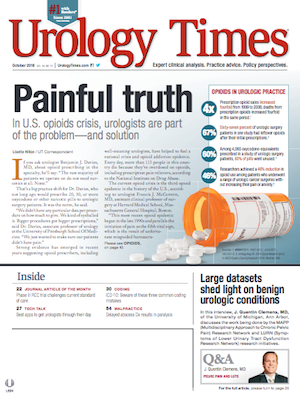Publication
Article
Urology Times Journal
IMRT ownership appears to influence PCa treatment
Author(s):
Retrospective cohort study identifies wide variation in treatment rates, spending.
San Francisco-Physician ownership of intensity-modulated radiation therapy (IMRT) facilities appears to influence the way men with newly diagnosed prostate cancer are treated, according to a recent study presented at the AUA annual meeting in San Francisco.
Read: Statins show benefit in Caucasian PCa patients
Previous studies have found an association between IMRT ownership and increased use of radiation therapy, Tudor Borza, MD, MS, explained. However, these studies have been criticized for their choice of control groups, lack of generalizability, and the fact that they did not evaluate IMRT ownership’s effect on overall treatment of prostate cancer, said Dr. Borza, who was a urologic oncology and health services research fellow at the University of Michigan, Ann Arbor, at the time of the study, working with Brent K. Hollenbeck, MD, MS, and colleagues.He is currently assistant professor of urology at the University of Wisconsin School of Medicine and Public Health, Madison.
For the current study, Dr. Borza presented data from a retrospective cohort of 19,063 men from a 20% Medicare sample. The authors sought to evaluate the effect of IMRT ownership on initial prostate cancer treatment (defined as receipt of radiation therapy, surgery, or cryotherapy within 1 year of diagnosis), treatment in men least likely to benefit (defined as treatment in patients with 10-year risk of non-cancer mortality >75%), and annual per-beneficiary price standardized spending. The men were age 66 years or older and were diagnosed with prostate cancer between 2010 and 2013, with 1-year follow-up through the end of 2014.
The men in the study were cared for by urologists representing 561 single-specialty groups. The authors performed Internet searches to determine IMRT ownership, looking for practices whose websites advertise IMRT services or who employed at least one radiation oncologist. They identified 88 practices.
Next: Wide variation in initial treatmentWide variation in initial treatment
The authors found wide variation in initial treatment, with treatment rates ranging from 47% to 87% and most of the IMRT-owning groups clustered “well above” the mean rate of 70%, according to Dr. Borza. Sixteen percent of IMRT-owning were groups were below the mean, while 57% were in the highest quartile.
For treatment in men least likely to benefit, the variation was greater, ranging from 15% to 80%. Fourteen percent of IMRT-owning groups were below the mean rate of treatment of 44%, while 43% were in the highest quartile.
Also see - Alcohol and the prostate gland: Friend or foe?
Annual spending ranged from $12,865 to $34,964, with a mean of $20,668. Eleven percent of IMRT-owning groups had spending below the mean, while 68% were in the highest quartile.
“These data are suggestive of the fact that IMRT ownership clearly plays a role in the way men with newly diagnosed prostate cancer are treated,” Dr. Borza said.
























